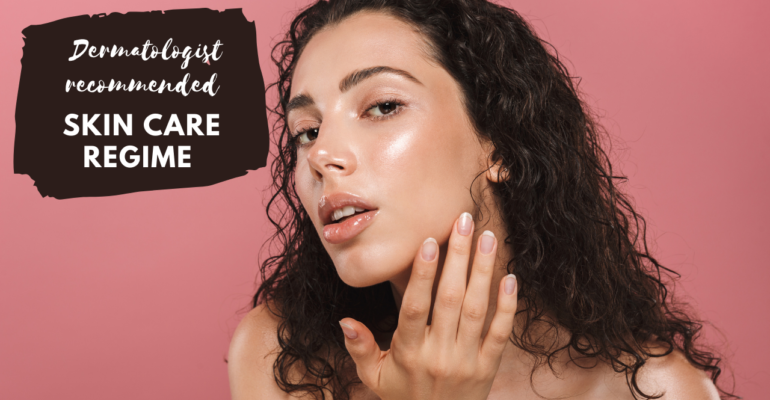Skin Care Routine- Dermatologist recommended
September 1, 2021 2024-03-04 6:22Skin Care Routine- Dermatologist recommended
As an Amazon associate, Dermatocare earns from valid purchase made by clicking on the affiliate links in this blog.

Skin Care Routine- Dermatologist recommended
In my role as a dermatologist, I’ve encountered a multitude of patients, each with distinct skincare needs and regimens. While some individuals lack the time or inclination to cleanse their face daily, others embark on elaborate 5- or 8-step rituals.
Interestingly, there exists no universal response to the query of how many steps constitute an essential skincare routine. The optimal regimen for you hinges on your specific skin type, concerns, and lifestyle.
Nonetheless, a set of fundamental stages holds significance for everyone as shown in this video:
https://www.youtube.com/watch?v=AzPS0bh3rP4
Morning skincare routine:
These morning steps are imperative:
Step 1: Cleansing
Cleansing serves the purpose of eliminating dirt, pollutants, oils, and dead skin cells from your complexion. Opt for a gentle, non-irritating facial cleanser. Steer clear of bar soap, which may prove abrasive for your skin.
Step 2: Moisturizing
Contrary to popular belief, a moisturizer isn’t advisable for every skin type. How do you determine if your skin necessitates moisturization? After washing your face, allow a few minutes to pass and assess your skin’s condition: If your skin appears oily, greasy, or excessively shiny, you can omit this step. If your skin feels parched and taut, gently apply moisturizer to your face and neck, massaging until absorbed.
Step 3: Treatment Product
The selection of facial cleansers and moisturizers hinges on your skin type. However, the choice of a treatment product is contingent upon your specific skin concerns, as elucidated in the accompanying video. The correct sequence for addressing these concerns is as follows:
- Sensitivity: Should your skin exhibit redness, bumps, irritation, itchiness, or a burning sensation upon sun exposure, contact with harsh skincare products, emotional triggers, or extreme temperatures, a treatment product containing ingredients such as ceramides, algae, aloe vera, cucumber, or niacinamide can contribute to soothing your skin. Proceed to the subsequent step solely if your skin remains calm and non-reactive.
- Acne: Minor issues like red pimples, whiteheads, blackheads, and enlarged pores can be managed with treatment products containing salicylic acid, niacinamide, clindamycin, tea tree oil, or azelaic acid.
- Pigmentation: Products infused with Kojic acid, arbutin, tranexamic acid, or azelaic acid can aid in diminishing mild dark spots, patches, or tanning.
- Aging: If major skin concerns are absent, initiating the use of Vitamin C in the morning as early as your twenties can facilitate rejuvenation, repair, de-tanning, and evening out your skin tone.
Step 4: Sun Protection
Apply sunscreen with an SPF of 30 or higher daily, even when skies are overcast, to counteract premature aging, wrinkles, and the risk of skin cancer stemming from the sun’s detrimental UV rays.
Step 5: Makeup
Makeup constitutes the final layer atop your skincare products.
Night skincare routine
The nighttime routine bears resemblance with minor alterations:
Step 1: Micellar Water
After makeup application, your skin accumulates layers of dust, pollutants, dirt, and other impurities. Hence, it’s advisable to cleanse your skin with micellar water to eliminate residual skincare products, makeup, and environmental pollutants that settle on your skin’s surface.
Step 2: Cleanser
Employ an appropriate facial cleanser to conclude the cleansing process and confer a fresh appearance to your skin.
Step 3: Moisturizer
Apply moisturizer solely if your skin feels dry or stretched; otherwise, this step can be skipped.
Step 4: Treatment Product
The choice of treatment product at night depends on your primary skin concern. However, you can incorporate more potent agents that might react with sunlight, such as:
- Adapalene or tretinoin for acne
- Glycolic acid or hydroquinone for pigmentation
- Retinols or peptides for aging skin
Weekly Skincare Regimen:
Exfoliation With age, the skin’s cell turnover accelerates, leading to the accumulation of dead cells on the surface, which imparts a dull and uneven appearance. Exfoliation serves to eliminate these dead cells, fostering a uniform complexion.
This can be achieved through physical scrubs that mechanically remove the outermost layer of dead cells, or through chemical peels administered by a dermatologist.
Various types of scrubs are available, necessitating careful selection based on your skin type. Dry skin benefits from a gentle, moisturizing scrub, while exfoliating scrubs are suitable for oily skin.
To apply a facial scrub, dispense a small amount onto your fingertips, then gently massage it in circular motions across your face and neck. Avoid the delicate eye area. Rinse the scrub with warm water and pat your skin dry.
Facial Masks Facial masks prove effective due to their extended contact with the skin, enabling a thorough absorption of ingredients. Moreover, they temporarily impart a tightening effect, enhancing skin firmness.
The selection of an appropriate face mask tailored to your skin type is of paramount importance. Dry skin benefits from a moisturizing face mask, while clay-based masks are ideal for oily skin.
Apply a thin layer of the face mask onto your face and neck, adhering to the recommended duration, before rinsing with warm water.
Alternatively, sheet masks offer a means of hydrating and nourishing the skin. Comprising a thin material soaked in a serum or essence, they are applied to a cleansed face, left for the designated duration, and subsequently massaged to infuse any residual serum into the skin.
ROUTINE FINDER
Get free dermatologist-recommended regime by choosing your skin or concerns.

FACE

HAIRS

CHILD

BODY
